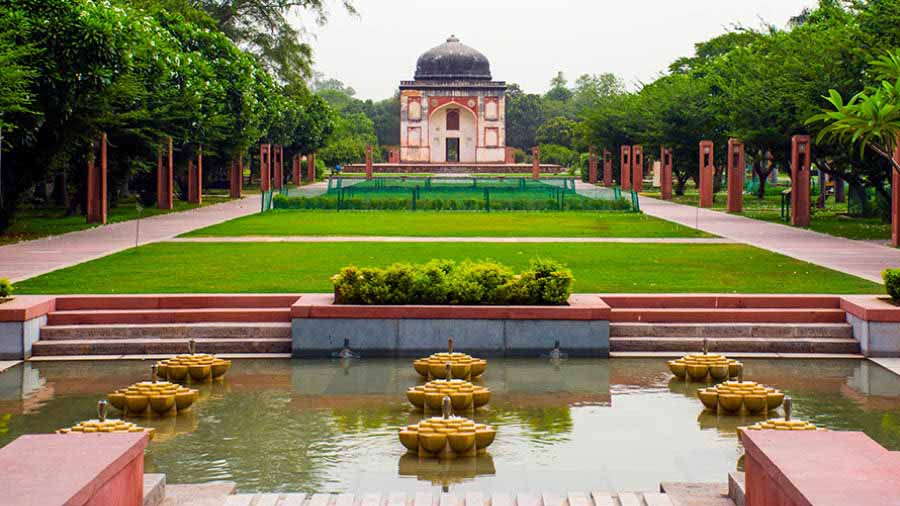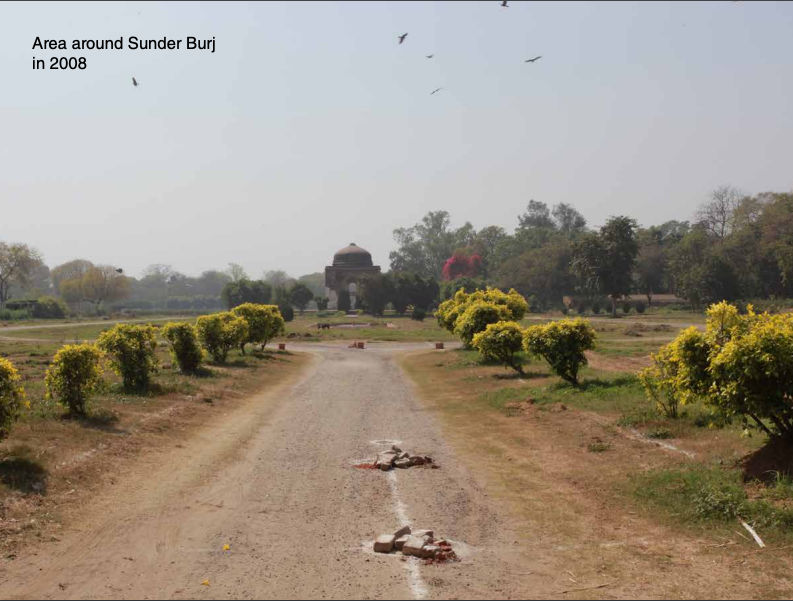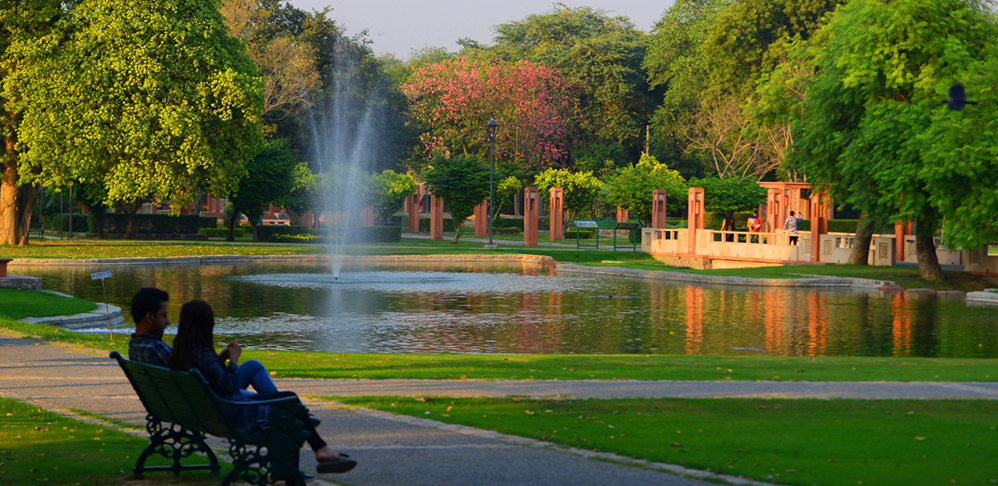
Once a burial ground for Mughal-era nobles adjacent to the Humayun's Tomb, the Sunder Nursery has now transformed into Delhi's favorite winter picnic spot.
Most casual visitors miss the fact that it was the tireless restoration work by the Aga Khan Trust for Culture in the last decade that has given Sunder Nursery its present look. It has now become not only an open-air museum for historic buildings but also a center of modern energy with Sunday markets, music events, and social gatherings.
From centuries-old architecture and rich biodiversity to scenic photography spots, this guide will help you make the most of your visit. We'll show you how to reach Sunder Nursery, what to look out for, and how to explore it on your own with a self-guided audio tour.

Reaching Sunder Nursery
Sunder Nursery is located just next to the Humayun's Tomb and Humayun Site Museum on the Mathura road. It spans 90 acres between the National Zoological Park and the Humayun Complex.
Nearest Metro
The most convenient metro station to reach Sunder Nursery is JLN Stadium on the Violet line. From the station, you can take a battery-operated rickshaw to the main entrance.
Entry Gate
The main entry gate to Sunder Nursery lies on the Bharat Scouts and Guides Marg.
Parking
There are designated parking areas near and inside the garden complex
The rate for car parking is ₹100 for 4 hours on weekdays & ₹200 for 4 hours on Sundays and Gazetted holidays. The rate for 2-wheelers is ₹35.
Timings
Sunder Nursery welcomes visitors from 7:00 AM to 9:00 PM. The garden remains open all seven days of the week, including public holidays.
Tickets
Tickets can be purchased to the Sunder Nursery at ₹ 50 for Indians/SAARC and ₹ 200 for others. A joint ticket to the 3 sites (Humayun's Tomb, Museum, and Sunder Nursery) is also available at a discounted price of ₹ 115 for Indian/SAARC citizens and ₹ 950 for other nationalities.
History of Sunder Nursery
The history of Sunder Nursery can be captured in four major transformations since the 16th century.
Azim Bagh (16th century)
Originally named Azim Bagh, this garden held significance during Humayun's reign (1530 - 1556). Its strategic location between Humayun's citadel (Purana Qila) and his tomb near the Yamuna river made it an important site in Mughal Delhi.
British Park (20th century)
The British repurposed the area into a botanical experimentation center, introducing plants from around the world to assess their suitability for the emerging imperial capital of New Delhi. This era shaped the nursery's landscape and enriched its botanical heritage.
Government Nursery (1947 - 2008)
After India's partition in 1947, the site served as a refugee camp before being converted into a government-run nursery. Over time, however, it fell into neglect. By the early 2000s, the once-thriving garden was largely forgotten, overgrown with vegetation, and in need of restoration.
Sunder Nursery (2008 - Present)
In 2007, the Aga Khan Trust for Culture (AKTC) initiated a restoration project in partnership with the Central Public Works Department (CPWD), the Archaeological Survey of India (ASI), and the South Delhi Municipal Corporation (SDMC). This transformation revived the area's heritage structures and landscapes.
The park was opened to the public in February 2018 and now welcomes over a million visitors every year, making it one of Delhi’s most loved green spaces.
Further reads: Nizamuddin Urban Renewal Initiative Annual Report 2021
Things To Do in Sunder Nursery
Today the Sunder Nursery is home to many heritage buildings and extensive flora and fauna. There are a range of things to do and explore inside, both as a visitor and as a local.
Explore 500-Year-Old Mughal Tombs and Monuments
Walk among beautifully restored 16th-century monuments, including Sunder Burj, Sunderwala Mahal, Lakkarwala Burj, and the Bada Batashewala Complex.
These tombs, part of the larger Humayun’s Tomb complex, are UNESCO restoration highlights.
Attend Live Events & Cultural Performances
The amphitheater and garden spaces at Sunder Nursery frequently host classical concerts, heritage walks, storytelling sessions, and Yoga and wellness mornings. Check out the official Instagram page for updates on upcoming events and workshops.
Visit the Winter Markets
Between November and February, don’t miss the seasonal markets featuring handcrafted goods, food stalls, plant nurseries, and artisanal products in a festive garden atmosphere.
Discover Rare Trees and Heritage Flora
Sunder Nursery is home to over 300 species of trees and plants, including
A restored central lake with aquatic vegetation,
A rare Miswak tree, traditionally used for oral hygiene,
Themed gardens like the Bonsai Garden and Rose Garden
A curated Butterfly Garden full of pollinator-friendly plants
Learn About Sustainability & Conservation
Sunder Nursery is a living lab of urban ecology, offering a look into innovative environmental practices:
Lake water conservation techniques
Model farm patches showcasing urban farming
Bee farms and apiary awareness corners
A dense Miyawaki forest patch, created to support biodiversity
Educational signage on flora, composting, and sustainability methods
Reconnect with Nature
Find your peace in the Wilderness Zone, perfect for quiet reflection, reading, or sketching. It even offers a unique opportunity for birdwatching in the early mornings.
Hang Out & Snap Some Memories
The nursery is filled with scenic photo spots. Pack a picnic or grab a coffee from the on-site café, and make a day of it with friends, family, or just your camera.

Walking Route
Follow this route to cover all the major attractions inside the garden.
Start at the main gate and immediately turn left
Explore the Sunder Burj
Past the Sunder Burj, walk by the Garden of Delight
At the end, turn left towards Rose Garden
Explore Lakkarwala Burj
Come back around to explore the Lake and Azim Bagh
Head to the far east to the Bonsai Park
Start heading south and pass by the Arched Pavilion
Take a detour to explore the Wilderness or head to Sunderwala Mahal
Take a detour to explore Bara Batashewala Mahal or head to the amphitheater.
Conclude at the Lotus Pond
Walking time: ~1 hour

You can download the Tourismo app and follow this trail guided by GPS and expert narration. Read more details here.
After Your Visit
After exploring Sunder Nursery, you can extend your historical and cultural tour by visiting these nearby attractions:
Humayun's Tomb (200 m)—A UNESCO World Heritage Site and burial ground for the Mughal family
Humayun Site Museum (200 m)—A museum focused on the Mughal era and Humayun restoration project
Nizamuddin Dargah (1 km)—Shrine of a revered Sufi saint, Nizamuddin Auliya
Khan Market (3 km)—A premium shopping destination with restaurants and cafes





